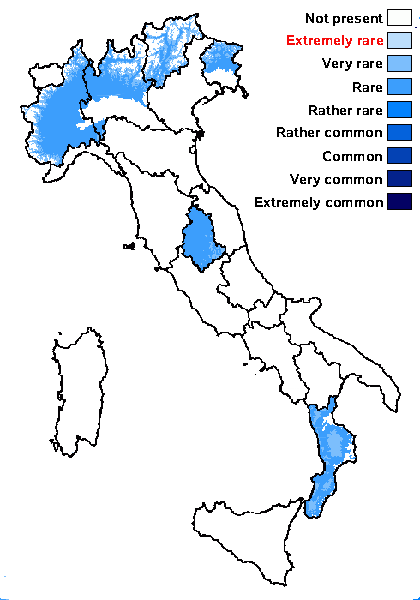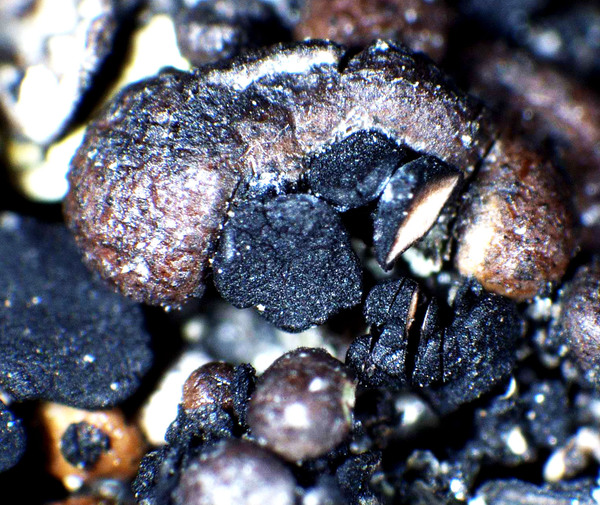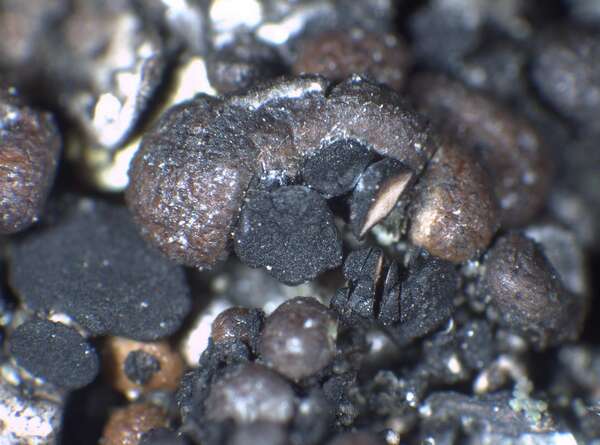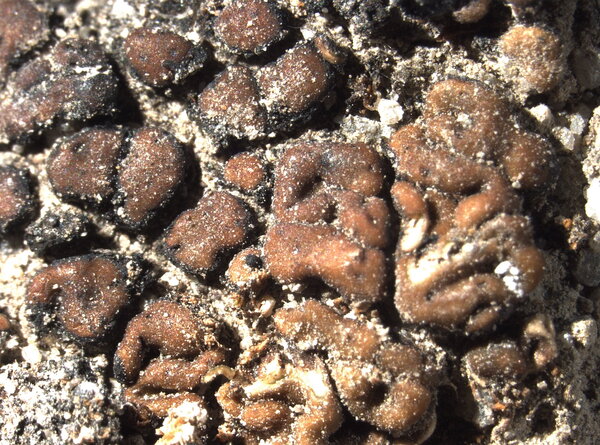Toninia tristis subsp. asiae-centralis (H. Magn.) Timdal
Opera Bot., 110: 112, 1991. Basionym: Lecidea asiae-centralis H. Magn. - Lich. Centr. Asia: 55, 1940.
Synonyms:
Distribution: N - Frl, TAA, Lomb, Piem (TSB 34198). C - Umb (Genovesi & Ravera 2001, Ravera & al. 2006). S - Cal (Puntillo 1996).
Description: Thallus squamulose, chestnut brown to dark brown, shiny. Squamules bullate, contiguous to scattered, up to 2(-3) mm wide, often with a central depression, with punctiform impressions developing into pores; lower surface pale. Upper cortex 40-160 µm thick, including an up to 100 µm thick epinecral layer, without crystals; algal layer continuous; medulla white, without crystals. Apothecia frequent, lecideine, strongly constricted at base, up to 2 mm across, with a black, flat to convex, smooth disc, and a distinct, smooth, concolorous proper margin. Proper exciple medium to dark brown (sometimes with a green tinge) in the rim, usually paler brown within, K-, N- or N+ violet, lacking crystals; epithecium brown, K-, N+ violet; hymenium colourless, 60-70 µm high; paraphyses not coherent, anastomosing, distinctly thickened above; hypothecium brownish-orange, with a K+ red pigment in upper part (and in the lumina of many paraphyses, asci and ascospores). Asci 8-spored, clavate, surrounded by a gelatinous I+ blue coat, with a well-developed I+ blue tholus, a I+ darker blue tube and a well-developed ocular chamber, Bacidia-type. Ascospores 1-septate, hyaline, ellipsoid to fusiform, 12.5-19 x 3.5-5.5 μm. Pycnidia dark, immersed. Conidia filiform. Photobiont chlorococcoid. Spot tests: thallus K-, C-, KC-, P-, UV-. Chemistry: thallus with terpenoids.Note: on calciferous rocks and soil; despite the name, this subspecies is widespread also in Southern and Central Europe, with scattered outposts north to Greenland.
Growth form: Squamulose
Substrata: rocks, soil, terricolous mosses, and plant debris
Photobiont: green algae other than Trentepohlia
Reproductive strategy: mainly sexual
Subcontinental: restricted to areas with a dry-subcontinental climate (e.g. dry Alpine valleys, parts of Mediterranean Italy)
Commonnes-rarity: (info)
Alpine belt: absent
Subalpine belt: absent
Oromediterranean belt: very rare
Montane belt: very rare
Submediterranean belt: rare
Padanian area: absent
Humid submediterranean belt: rare
Humid mediterranean belt: very rare
Dry mediterranean belt: absent

Predictive model
Herbarium samples
Growth form: Squamulose
Substrata: rocks, soil, terricolous mosses, and plant debris
Photobiont: green algae other than Trentepohlia
Reproductive strategy: mainly sexual
Subcontinental: restricted to areas with a dry-subcontinental climate (e.g. dry Alpine valleys, parts of Mediterranean Italy)
Commonnes-rarity: (info)
Alpine belt: absent
Subalpine belt: absent
Oromediterranean belt: very rare
Montane belt: very rare
Submediterranean belt: rare
Padanian area: absent
Humid submediterranean belt: rare
Humid mediterranean belt: very rare
Dry mediterranean belt: absent

Predictive model
| Herbarium samples |
 Index Fungorum
Index Fungorum
 GBIF
GBIF





